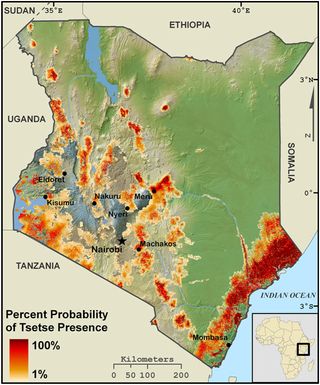Solving the Sleeping Sickness ‘Mystery’

Since before the 1300s, people living in many parts of Africa have been dying from a disease known as sleeping sickness. Despite public health campaigns that explain ways to stop infection—primarily by killing the disease-spreading tsetse fly—successful eradication has remained out of reach. That’s partly because epidemiologists can’t predict where cases will emerge next.
“It’s in places where people thought it shouldn’t be, and it’s not in places where they’re sure it should be,” says Joseph Messina, a geographer at Michigan State University.
Now, Messina’s effort to map future tsetse fly distribution may help solve this sleeping sickness “mystery.”
No ordinary bug
The tsetse fly isn’t like most insects. For instance, it has a very low reproductive rate, laying a single live pupa in the soil just a few times each year. The flies travel so fast that they can dart into a moving car to bite someone. The good news is that they’re also very dependent on environmental conditions, meaning they die off quickly if it’s too hot, too cold or too dry.
“As long as you have the right kind of climate for part of the year and a corridor for tsetse to move through, you’ll find it,” says Messina.
The tsetse is also an efficient carrier of trypanosomes, the parasite that causes sleeping sickness. When the fly bites into its host, it injects the parasite. The parasite eventually reaches the bloodstream, where it can travel to other sites in the body. If left untreated, the host may experience neurological problems, including confusion, fatigue and disrupted sleeping patterns—hence, a “sleeping sickness.” Coma and death may follow. The disease’s annual toll is about 50,000 human fatalities and $4.5 billion in livestock losses.
Sign up for the Live Science daily newsletter now
Get the world’s most fascinating discoveries delivered straight to your inbox.
“If I can do anything to reduce the number of people burdened by the disease,” says Messina, “I’ll be very happy.”
Mapping distribution
Four years ago at a meeting in Nairobi, Kenya, Messina and his colleagues hatched a plan to use climate and land cover data to model tsetse fly distribution in that east African country, where the tsetse fly has started to move into more areas. The goal was to predict future hotspots of sleeping sickness, which would aid efforts to strategically trap and spray tsetse fly populations and prevent an epidemic.
Messina and his team tapped into NASA’s free resource of worldwide vegetation, temperature and land cover data that are updated every 16 days. This information, along with knowledge about tsetse ecology, enabled the researchers to make educated guesses about where the fly was likely to be. After spending a year experimenting with the design of a predictive mathematical model, they now can enter the NASA data into a model to generate detailed maps of Kenya that show tsetse locations.
“The model has been doing a very good job of locating the fly,” says Messina.
He notes that it also has revealed some surprising distribution patterns. For instance, the model shows that the amount of land the fly occupies from month to month and year to year really varies. This makes sense when you consider that climate is not consistent across Kenya. Yet the model also has pointed to particular areas—tsetse “reservoirs” and “refugia”—where the flies always can be found. Messina says these places may be good spots for routine trapping and spraying.
The next goal for the modeling effort is to incorporate weather prediction data, so that the research group can make real-time estimates of fly distribution in the near future.
“Given the current climate scenarios, it’s likely that many parts of Kenya, including the agricultural areas, will become suitable habitat for tsetse,” says Messina. “If we can predict where tsetse will be, we can say, ‘Set up your traps now because they’ll be here in 2 weeks.’ Because of this, we’ll be able to control the disease so much more effectively than ever before.”
This Inside Life Science article was provided to LiveScience in cooperation with the National Institute of General Medical Sciences, part of the National Institutes of Health
